A Low Cost Set of Indian Head Half Eagles
For much less than the cost of a set of Uncirculated Indian Head half eagles (U.S. $5 gold coins), a set of About Uncirculated (AU) grade coins may be assembled. Other than their little brothers, Indian Head quarter eagles, Indian Head half eagles (1908–29) are the least expensive of all U.S. gold types to collect by date (including representatives of all combinations of years and mint locations).
For much less than the cost of a set of Uncirculated Indian Head half eagles (U.S. $5 gold coins), a set of About Uncirculated (AU) grade coins may be assembled. Other than their little brothers, Indian Head quarter eagles, Indian Head half eagles (1908–29) are the least expensive of all U.S. gold types to collect by date (including representatives of all combinations of years and mint locations).
A set of AU grade Indian Head half eagles would cost only a small fraction of the cost of a set in MS64 to MS66 grades. For example, the CPG ® retail price estimate for an AU50 grade 1912-S is $704 while the CPG® estimate for a MS65 grade 1912-S is $186,000. No one is disputing the point that a certified MS65 1912-S is likely to be of much higher quality than a certified AU50 1912-S. Regardless of the latter’s imperfections, however, an AU50 grade 1912-S might be a better value for most interested collectors and would certainly be more likely to fit into the respective budgets of most collectors of classic U.S. coins. If I had $10 billion, though, I might spend $186K for a 1912-S half eagle that I really liked
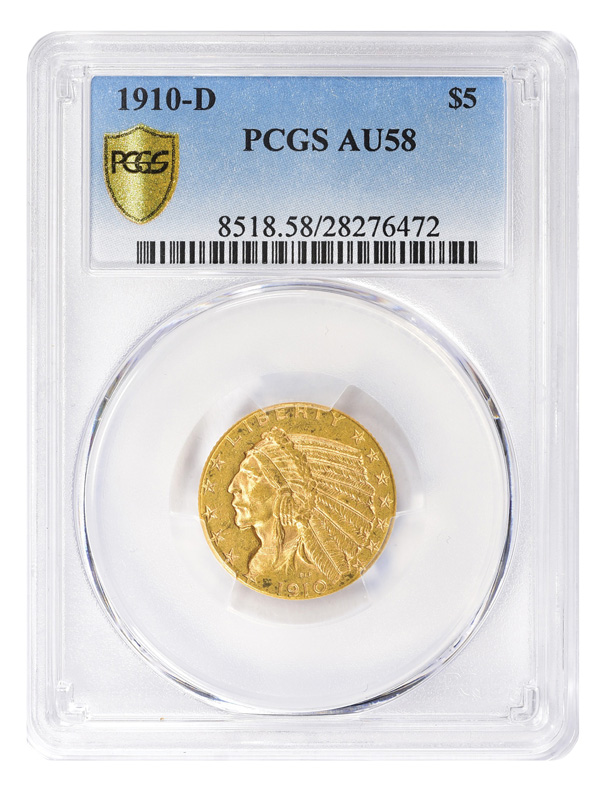
1910-D $5 AU58, PCGS. Image courtesy of GreatCollections Coin Auctions.
Only four coins in the series are CPG® estimated to retail for
more than $,1000 each in AU grades: 1908-S, 1909-O, 1911-D and 1929. I
contend that it would not be difficult to find a PCGS or NGC graded AU50 to
AU55 grade 1908-S for well under $1,000. A collector may end up spending
more than $1,000, however, for an AU grade 1909-S or 1915-S half eagle, the
values of which have been underestimated by editors of some price guides.
For the presently discussed quest to have meaning, all the dates, including the just mentioned 1909-S and 1915-S, should be included, except perhaps the 1929 as it is from a different political and economic era. When I was a kid, collecting by date meant including all combinations of year plus mint location! I have been talking to coin collectors for decades and have interviewed many.
I never met anyone who collected post-1838 U.S. coins by date and ignored mintmarks. When the PCGS registry was founded, I found it odd and incorrect that PCGS referred to collecting by year as collecting by date!
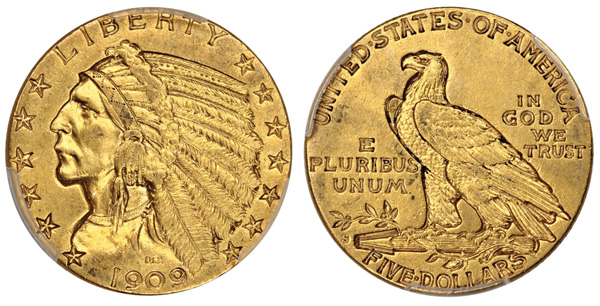
1909-S $5 AU50, PCGS. Image courtesy of David Lawrence Rare Coins.
As far as I know, a set of Lincoln cents has always needed to include a
1914-D and a 1909-S VDB. It would otherwise be incomplete. No collector who
I ever knew thought that the requirement for a 1914-Denver Mint Lincoln
cent could be avoided by acquiring only a 1914 Philadelphia Mint cent.
Regarding the year 1909, there are four dates of Indian Head half eagles: 1909 (without a mintmark), 1909-D, 1909-O and 1909-S. This is the only year in the series for which four different mints are represented. For MS64 and higher grade coins, the 1909-O is the key date. Note that the term key date incorporates a reference to a mint location. A 1909-O is a key date while a 1909-D is a very common date. For sub-64 grade Indian Head half eagles, especially circulated coins, the 1929 is the key date.
For building a set of AU grade Indian Head half eagles, one strategy is to be a price-buyer and be aware that many coins acquired will have substantial imperfections in addition to ordinary wear. Tens of thousands of Indian Head half eagles were accidentally or deliberately harmed, usually while being kept for their gold content. Moreover, many dealers artificially brightened them to make these more salable or used substances to cover contact marks and scratches. When coins are sold to the general public, many sellers figure that very few buyers will carefully inspect the coins and know how to interpret them.
There are also collectors and non-collectors who received gold coins as gifts and then cleaned them with chemicals that harmed the surfaces of the coins. There were varying degrees of harm due to different kinds of cleanings. Is there a clear dividing line between cleaned coins that receive numerical grades from grading services and those that are placed in “Details’ holders without numerical grades?
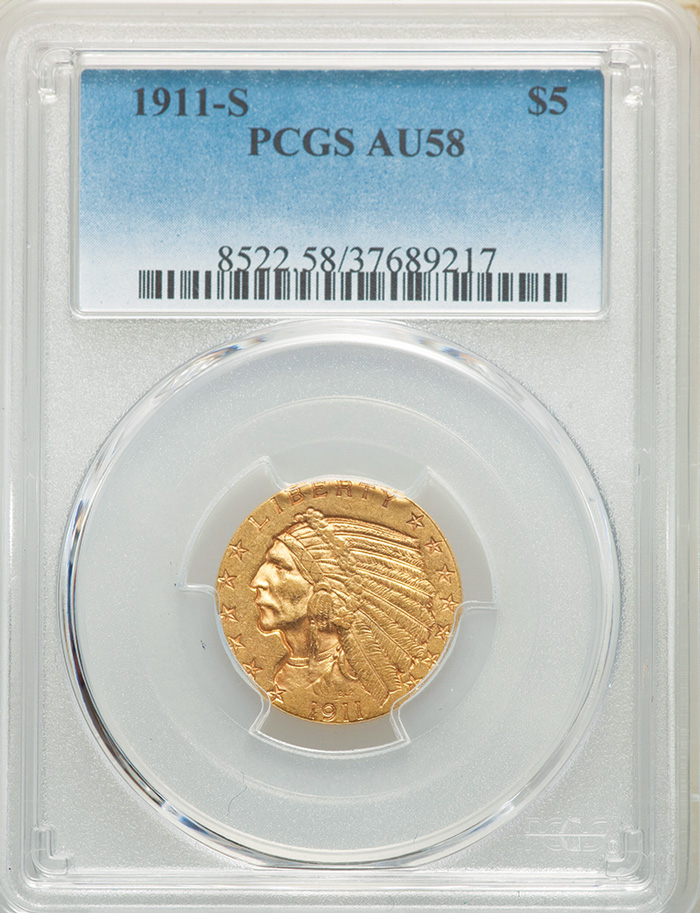
1911-S $5 AU58, PCGS. Images courtesy of Heritage Auctions.
While it would make sense to consider CAC approved Indian Head half eagles,
very few Indian Head half eagles in the AU50 to AU58 grade range have been
CAC approved. A CAC-only, AU grade set may not be practical and would cost
much more. Besides, buying coins with notable negative issues contributes
to the education of collectors.
Two Indian Head half eagles of the same date that have been graded AU55 by the same grading service may be tremendously different in terms of originality and surface quality. Those collectors who are very interested in originality and technical factors should devote time and effort into examining coins and posing questions to experts. Those who are not so interested in the physical characteristics, however, may just buy certified AU grade Indian Head half eagles and enjoy assembling a set without thinking much about the quality of the coins.
In the framework of classic U.S. gold coins (1795 to 1933), AU grade Indian Head half eagles are extremely inexpensive. A set of Capped Head half eagles (1813-34), in contrast, would cost well over a million dollars to even 90% complete by date in AU50 or higher grades.
A price-buyer, someone who shops for relatively low priced items, of AU grade Indian Head half eagles should not obsess about quality or originality and should accept the reality that a few coins acquired may have glaring imperfections. Some of the coins acquired will have been significantly cleaned, artificially brightened, banged up or substantially scratched. These are still true classic U.S. gold coins that are enjoyable to collect and learn about.
Beginners may become knowledgeable collectors through experience, careful thinking, and effecting inquiries. Some collectors do not wish to take the time and put forth the effort to become knowledgeable. They just wish to enjoy collecting. AU grade Indian Head half eagles are especially suitable for more than one kind of collecting objective. A relatively low cost set can be completed in a matter of months.
It is easy to find a 1908 Indian Head half eagle for less than $850. On February 1, the Goldbergs auctioned a PCGS graded AU50 1908 for $588.
In AU55 to AU58 grades, the 1908-S is a better date, really a semi-key. In AU50 to AU53 grades, however, it is much less scarce. In January 2019, the Goldbergs auctioned a PCGS graded AU55 1908-S for $1,260. A PCGS or NGC graded AU50 or AU53 1908-S could be found for well under $1,000.
On March 7, GreatCollections sold a PCGS graded AU58 1909 for $760.50. On January 10, 2021, GreatCollections sold an NGC graded AU55 1909-D for $618.75.
Key dates are discussed after common dates, as I suggest collectors complete most of the set before acquiring the two keys. It makes sense to gain some buying experience and to see a significant number of pertinent coins before buying the most expensive coins in a set.
On May 5, Heritage sold a PCGS graded AU55 1909-S for $1,050. On March 14, the firm of David Lawrence sold a PCGS graded AU50 1909-S for $825. Although recent public sales of certified, AU grade 1909-S half eagles have been way above trend lines over the past few years, I suggest that one could still be found for less than $825, perhaps at a medium size coin show.
On May 19, Stack’s Bowers sold an NGC graded AU58 1910 for $840. On March 14, GreatCollections sold a PCGS graded AU58 1910-D for $843.75. On February 21, GreatCollections sold a PCGS graded AU58 1910-S for $990.
On February 14, GreatCollections sold a CAC approved, PCGS graded AU58 1911 half eagle for $753.75. This was probably a very good deal.
The 1911-D is not nearly as important a date as it is in the realm of quarter eagles, though it is a semi-key date in the series of half eagles. On April 25, Heritage sold an NGC graded AU55 1911-D for $2,340. The day before, Heritage sold an NGC graded AU58 1911-D for $4,812, a very strong price. For a gold coin collector on a tight budget, a sensible selection might have been the 1911-D that Stack’s Bowers auctioned on March 26, which was PCGS graded XF45 and realized $1,110.
In circulated grades, the 1911-S is common. On April 7, Heritage sold a PCGS graded AU53 1911-S for $660 and a PCGS graded AU58 1911-S for $699.60.
The 1912 and the 1913 are extremely common. The 1912-S and the 1913-S are somewhat better dates, and usually cost more than the most common dates in the series. On March 3, Heritage sold an NGC graded AU58 1912-S for $870.
On April 1, Stack’s Bowers sold a PCGS graded AU58 1913 for $660. On January 20, Heritage sold an NGC graded AU58 1913-S for $810.
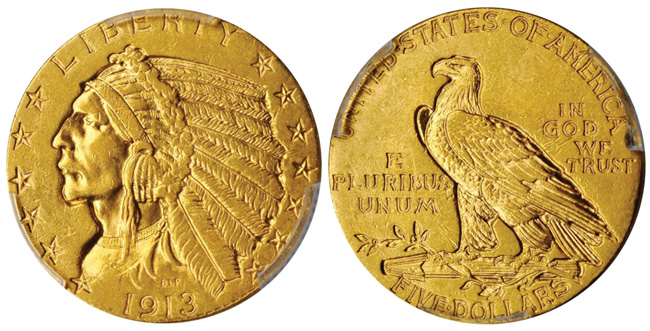
1913 $5 AU58, PCGS. Image courtesy of Stack's Bowers Auctions.
In circulated grades, the 1914 and the 1914-D are among the most common
dates. In gem grades, they both command substantial premiums.
On January 10, GreatCollections sold an NGC graded AU58 1914 for $596.25. On February 24, Heritage sold an NGC graded AU58 1914-D for $750.
The 1914-S is worth a slight premium in circulated grades and a very large premium in mint state grades. The CPG® retail estimate for an MS64 grade 1914-D is $3,880. The CPG® retail estimate for an MS64 grade 1914-S is more than twelve times as much, $46,800. On April 25, GreatCollections sold an NGC graded AU53 1914-S for $658.12.
In grades below MS64, the 1915 is one of the most common dates. On April 1, Stack’s Bowers sold a PCGS graded AU58 1915 for $600. Evidently, this piece was fresh. It was consigned as part of the collection of Silas Stanley Roberts, who died in 1966.
The 1915-S is surprisingly scarce in a series that is characterized by common coins, several of which are extremely common. Indeed, my research indicates that the number of 1915-S half eagles that survive is dramatically lower than the number of survivors for each of the common dates. The 1908, the 1909-D, the 1912 and the 1913 are among the most common.
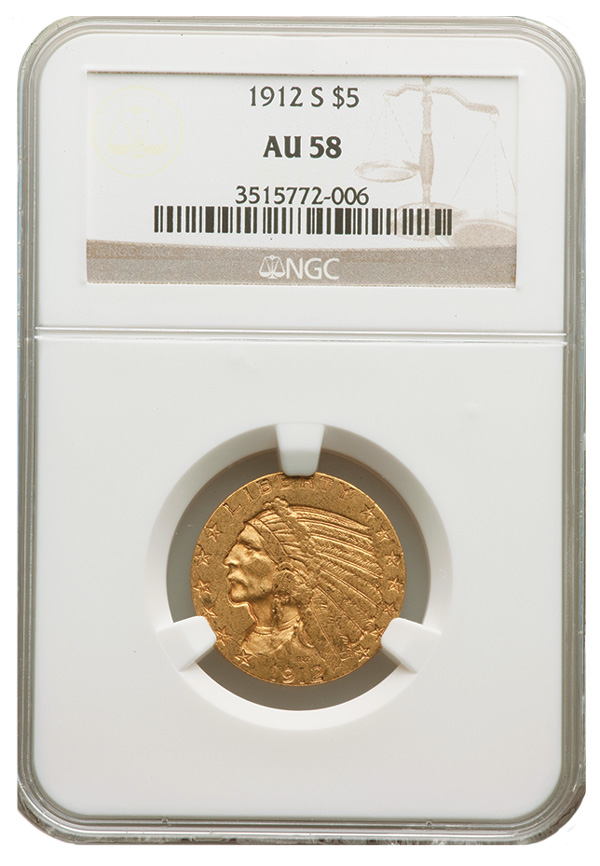
1912-S $5 AU58, NGC. Images courtesy of Heritage Auctions.
On February 7, GreatCollections sold an NGC graded AU55 1915-S, with a CAC
sticker, for $1,041.75. While I believe that some price guides
underestimate the value of circulated 1915-S half eagles, some price guides
tend to overestimate the value of circulated 1916-S half eagles. While the
1916-S is not as common as the common dates, it is not much scarcer.
On April 1, Stack’s Bowers sold a PCGS graded AU55 1916-S for $660. In 2020, PCGS graded AU55 1916-S fives publicly sold in the $630 to $660 range. On February 7, 2021, GreatCollections sold an NGC graded AU58 1916-S for $857.25.
Indian half eagles were not minted again until 1929. Public opinions regarding U.S. gold coins had changed in the interim. They were much less likely to be spent.
The 1929 Indian Head is certainly extremely scarce and is probably almost rare. I figure that there are between 480 and 635 1929 half eagles in existence. These did not circulate to a significant extent. Some choice uncirculated 1929 half eagles were properly stored, though many were terribly treated by people who knew little about scarce coins.
On March 25, Stack’s Bowers auctioned a 1929 half eagle in a PCGS holder with a details label, “Cleaned – UNC Detail.” This 1929 realized $24,000. This is the only coin mentioned so far in this discussion that I have examined. This 1929 half eagle was processed to the point that its color is extremely unnatural, and it has additional problems.
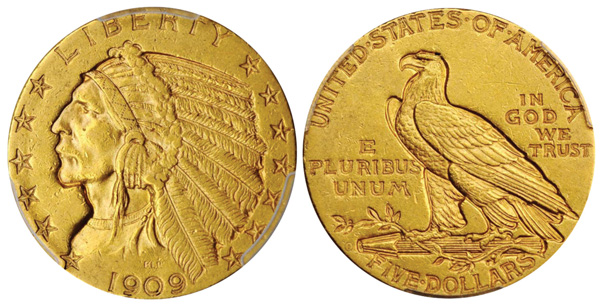
1909-O $5 AU53, PCGS. Image courtesy of Stack's Bowers Auctions.
A 1929 half eagle, which Heritage auctioned in February for $11,700, may have been a better value. I did not see that 1929 half eagle, though images suggest that it has numerous pricks and several gashes. The label on its PCGS holder indicates that it is genuine, “Damage – AU Detail.” Its detail is impressive. Back in June 2018, Stack’s Bowers auctioned a PCGS graded AU50 1929 for $19,200.
As the 1929 is from a later era and really is historically distinct from the other Indian Head half eagles, a set dating from 1908 to 1916 may be complete enough in the minds of most interested collectors. The 1909-O would then be the only key.
On March 26, Stack’s Bowers auctioned a PCGS graded AU53 1909-O for $7,800. On April 25, GreatCollections sold a non-gradable 1909-O in an NGC holder, “VF Details / REV GRAFFITI,” for $4,261.20. On April 24, Heritage sold two circulated 1909-O half eagles, a PCGS graded AU53 coin for $9,000 and a PCGS graded XF40 coin for $5,760.
For less than $35,000, perhaps much less, a collector could build a set of PCGS or NGC certified AU grade Indian Head half eagles, missing a 1929, though with most coins certified as grading AU55 or higher. Including a 1929, the total cost could be well under $60,000. The total cost of a complete set may be significantly reduced if a 1909-O and a 1929 in XF40 grade or in Details holders were selected.
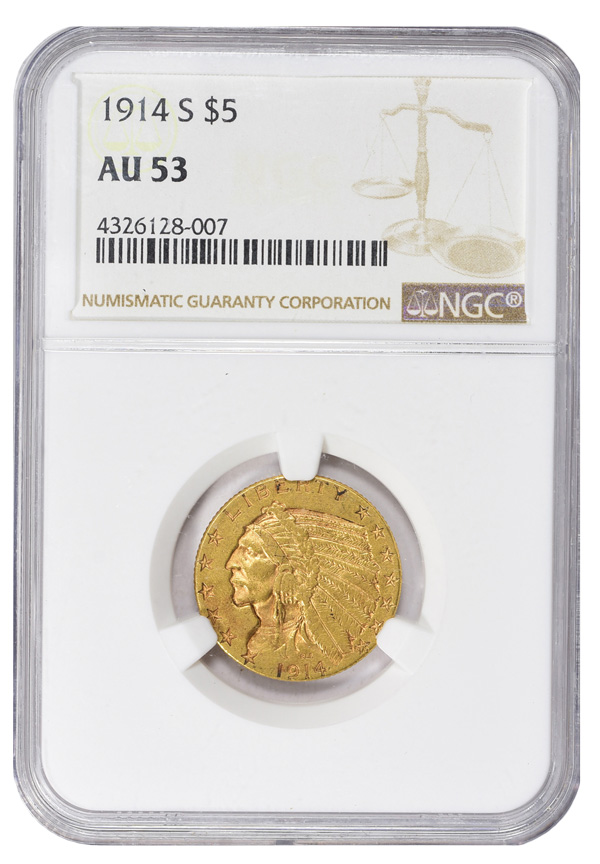
1914-S $5 AU53, NGC. Image courtesy of GreatCollections Coin Auctions.
In contrast, a set of PCGS or NGC graded MS65 grade Indian Head half eagles
may cost as much as $1.5 million, if it could even be completed. A set of
certified MS64 grade Indian Half eagles might cost $500,000 in 2021.
Although all classic U.S. gold coins could very well rise in value during this decade, coin buyers should not assume that they will rise in value at all. It is important for each collector to spend amounts that he or she can afford to lose, while enjoying collecting. It is often fun to build several sets of very different design types.

Download the Greysheet app for access to pricing, news, events and your subscriptions.
Subscribe Now.

Subscribe to CPG® Coin & Currency Market Review for the industry's most respected pricing and to read more articles just like this.
Source: Greg Reynolds









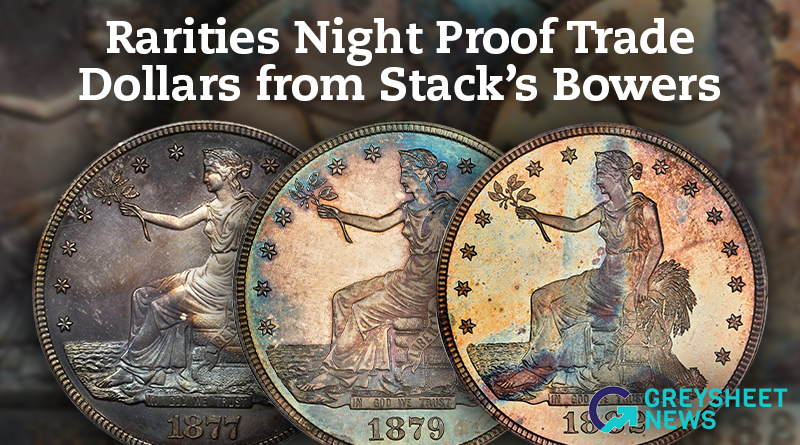
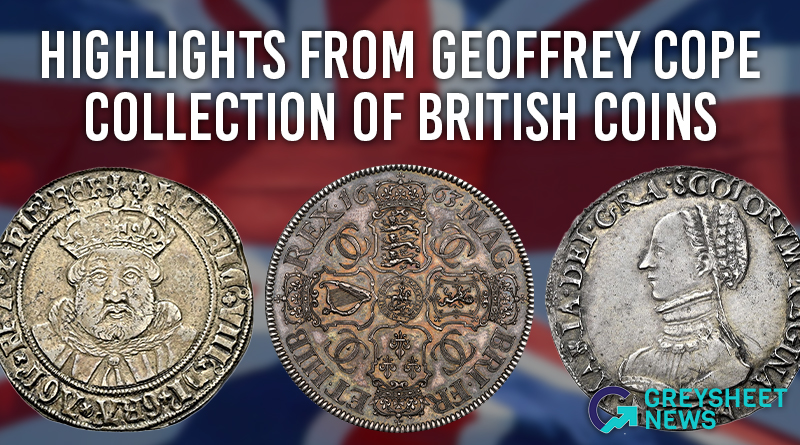
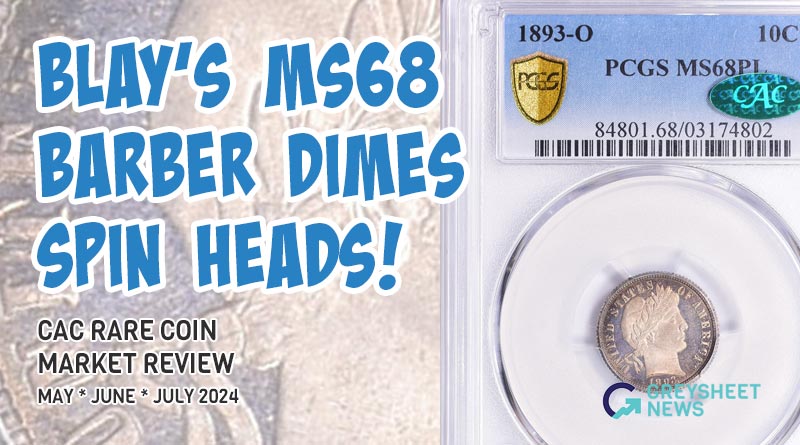
Please sign in or register to leave a comment.
Your identity will be restricted to first name/last initial, or a user ID you create.
Comment
Comments